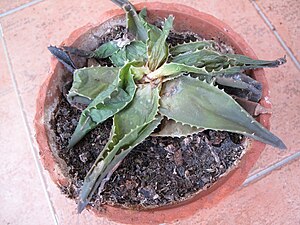Other signs are shown when the shoot tips on your plants start to die back. If the flowers on the plant don't open fully or they become discolored and then start to die off, then these are also signs that frost damage might have occurred.
| Frost-damaged aloe vera plant. (Photo credit: Wikipedia) |
Sometimes frost damage is not noticeable for a few days after a frost has occurred and this is particularly so if the frost was a very light one.
The best way to protect against frost damage, or to reduce the effect that frost might have on your garden is to choose the best plants for your climate conditions. If you are living in an area that is susceptible to frosts then your best course of action is to choose plants that are frost-tolerant.
By planting in areas that are exposed or where frosts occur more frequently you will increase the chances of losing plants to frosts, so it is wise to plant in sheltered spots or areas other than where there are frost pockets.
In the early fall or late spring, you can offer some temporary protection to your plants by wrapping them in Hessian cloth or frost cloth until after the period of frost has passed.
This time of year though, the end of the road is inevitable for many of our summer garden plants. It's been a great season, and I hope you've enjoyed your gardening experiences this summer as well!


No comments:
Post a Comment